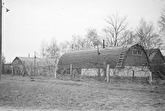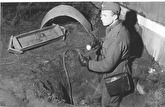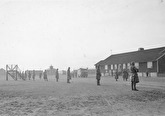Welcome to the Swedish Artillery Museum
The text below is translated by machine.
History
Throughout World War II fled soldiers who fought for the Nazi Germany to Sweden . In Sweden, these were placed in one of the four custody continue: Ränneslätt outside of Eksjö, Market and Budget near Uddevalla and in camp Lingen in Havdhem on Gotland. Some of these were deported immediately, sometimes to the waiting firing squard. With the Soviet offensive against the Baltic States and Finland fled the fall of 1944 a large number of Germans, Finns, and Baltic peoples to Sweden. About one third of these were deserters, one third of demobilized soldiers, as well as a third Finn, in varying degrees, voluntarily fought for Germany. At the end of May was 3 200 people interned in camps. The camp was closed in October 1945 in Havdhem, and detainees were placed in a camp in Rinkaby , outside Kristianstad. Near Rinkaby opened a fifth camp, Gälltofta.
On June 2, 1945 the Soviet Union submitted a note to the Swedish coalition Government the military and similar personnel from the eastern front who been detained in Sweden would be returned to the Soviet Union according to the German surrender terms. On 16 June the Swedish Government responded that it did not intend to prepare a refuge for German and German military personnel. Although Sweden was neutral during the war and not bound by the German surrender terms.
The Government's response was kept secret until november 1945. On 15 november, the Government convened a press conference where prime minister Hansson and foreign minister Undén bad press about silence until they had time to arrange better monitoring of camps. The news was revealed, however, two days later of two newspapers that have not participated in the press conference, the daily record and Vestmanlands Läns Tidning .
The news attracted much attention when it meant that about 160 Baltic citizens were sent to the Soviet Union and, it was assumed, be punished as traitors . The Soviet Union had occupied and annexed the Baltic States before the war (see Molotov-Ribbentrop Pact) and therefore regarded the Balts as Soviet citizens, adopted it. The situation of the German prisoners, 2 370, attention in the same way as it was assumed that these should only be treated as prisoners of war .
Hunger strike
On 22 november opened the Balts an hunger strike . The day after the Parliament held an interpellation debate, but in addition to individual MPs stood parties from the coalition Government firm on the decision. SKP wanted to go further and even send back the 30 000 civilian refugees from the Baltic States.
On 24 november the Germans also began a hunger strike. On november 27 the Baltic were hunger strikers hospitalized and the day after the Swedish Government decided that the extradition would be postponed until further notice. The Germans were treated differently, and for their part began the extradition on november 30 with the Soviet ship Cuba. On 14 and 16 december continued claim to a Soviet hospital ship.
On January 8, there were 300 inmates left in camps Rinkaby and Gälltofta. On January 25 the operation to the final extradition to the Soviet Union when about 150 balter and 230 Germans was extradited to the Soviet vessel Belo Ostrovsky in Trelleborg.
Self-mutilation
The desperate soldiers maimed themselves so as not to be extradited. One of them drove into a Pencil in the eye; other chopped off his fingers. A total of 2 518 people were extradited to the Soviet Union, hence the 146 balter. 310 Germans and 54 poles returned to their home countries. 104 people remained in Sweden. At least seven of the inmates committed suicide during the course of events.
The Balts ' fate after the extradition
146 The Balts was put in a prison camp after arrival in the Soviet Union, such as generally was for soldiers in German service. Three were executed for crimes they committed as soldiers, 23 were sentenced to long prison terms. The other was released within a few months.
After the game
The subject has been described by Per Olov Enquist in documentary novel The Legionnaires (1968). Johan Bergenstråhle used the novel as the model for the movie Swedish extradition (1970). A review of Enquist 's documentary novel noted that the author "not cancelled his major work on the Swedish extradition only of historical interest. He wanted to use research as a means of political positioning in the current situation ".
The social democratic politician and former Foreign Minister Sten Andersson maintains that the claim was true.
In international law, there was no requirement for extradition. According to the Hague Conventions require a neutral State after the war did not disclose any squad to any party. On the other hand, the Soviet Union and the Western Allies agreed that surrenders from the axis side would be handed over to the front from which they fought. Furthermore, among others, historian Åsa Linderborg meant that Baltic soldiers also took part in the the Holocaust and other war crimes-which is sometimes forgotten when a Baltic tragedy has been discussed. In addition, writes Economist Mats Deland: "we know through modern historical research to Estonian, Latvian and Lithuanian units were involved at all levels both in the Holocaust of the Jews, as well as in the mass killings of Communists, prisoners of war, Roma and others. They helped to cordon off the areas in which the victims were led by, they took part in the race through the streets and forests and they let themselves be lent to the firing squard.
Trelleborg was during the second world war the Centre for many dramatic events, such as the transit transport between Germany and Norway, prisoner exchanges, Trelleborgsrederiernas shipwrecks, and Swedish extradition to the Soviet Union in the port of Trelleborg. To remind you and give the families of victims a place to visit, honored the memory of Trelleborg with a Memorial, "stranded refugee ship" (1999-2000), performed by the artist Christer Bording.
Year 2004 produced the regional Museum of Kristianstad led by the curators Lars Buhrgard and Peter R traveling exhibition "a Baltic tragedy-a Swedish trauma in the shadow of the second world war".
Belated apology
Officially asked the Swedish Government to apologize on 20 June 1994. The 44 survivors were invited to Sweden. Forty survivors, 35 Latvians, four Estonians and Lithuanians arrived, and was received by King Carl XVI Gustaf. Foreign minister Margaretha af Ugglas said the extradition decision was rash and improper, that the Swedish Government unreservedly agree with the criticism of this decision and apologizes for injustice. The following days were visited including Eksjö and Gotland. [10] Still, there is no political consensus on whether the extradition was right or not. Du kan ändra denna exempeltext. Lorem ipsum dolor sit amet, consectetuer adipiscing elit. Donec libero. Suspendisse bibendum. Cras id urna. Morbi tincidunt, orci ac convallis aliquam, lectus turpis varius lorem, eu posuere nunc justo tempus leo. Donec mattis, purus nec placerat bibendum, dui pede condimentum odio, ac blandit ante orci ut diam.





